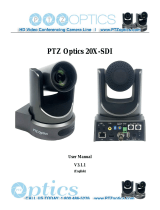
Menu List
9
Menu item Value (bold text: default value) Explanation
AUDIO IN 5/6, SDI IN 1–4, HDMI IN 5–6
DIGITAL GAIN -42.0–0.0–42.0dB This adjusts digital gain.
PGM LEVEL
-INF–10.0dB
(*14)
-INF–0.0–10.0dB
(*15)
This adjusts the level that is output to the PGM/1 bus.
PVW LEVEL
-INF–10.0dB
(*14)
-INF–0.0–10.0dB
(*15)
This adjusts the level that is output to the PVW/2 bus.
PGM MUTE OFF, ON
This turns on/o the mute function for the PGM/1 bus. If this is “ON,” the audio of the PGM/1
bus is muted (silent).
PVW MUTE OFF, ON
This turns on/o the mute function for the PVW/2 bus. If this is “ON,” the audio of the PVW/2
bus is muted (silent).
HPF 75Hz OFF, ON
This sets the high-pass lter on or o.
Eect This cuts o unneeded low-band audio. The cuto frequency is 75 Hz.
DELAY
0.0–500ms
(0.0–29.9/25.0frame)
This adjusts the delay time for input audio.
Eect This outputs audio with a delay.
GATE OFF, ON
This sets gate on or o.
Eect This mutes audio that is below a specied level.
GATE THLD -80.0– -50.0–0.0dB
This sets the level used as the threshold for removing audio. Audio below the level set here is
removed.
GATE RELEASE 30–860–5000ms
This adjusts the length of time until the audio is fully attenuated after audio falls below the
threshold.
COMP OFF, ON
This sets the compressor on or o.
Eect This compresses audio that exceeds a specied level.
COMP THLD -60.0– -30.0–0.0dB
This sets the level used as the threshold at which the compressor is applied. Compression is
applied to audio that exceeds the threshold.
COMP RATIO
1.00:1, 1.12:1, 1.25:1, 1.40:1,
1.60:1, 1.80:1, 2.00:1, 2.50:1,
3.20:1, 4.00:1, 5.60:1, 8.00:1,
16.0:1, INF:1
This species the degree of compression applied to the audio.
If this is set to “1.00:1,” compression is not applied.
COMP ATTACK 0.2–1–100ms This sets the time until compression starts when audio exceeding the threshold is input.
COMP RELEASE 30–380–5000ms This adjusts the length of time until compression ends after audio falls below the threshold.
COMP AUTO G OFF, ON
This switches the auto makeup gain feature on and o.
When this is set to “ON,” the nal output volume level after applying the compressor is
automatically adjusted according to the “COMP THLD” and “COMP RATIO” settings.
The total of the “COMP MAKE UP G” setting value described below and the value calculated by
auto makeup gain becomes the nal output volume level (up to +34 dB).
COMP MAKE UP G -40–0.0–40dB This adjusts the nal output volume level after applying the compressor.
EQUALIZER OFF, ON
This sets the equalizer on or o.
Eect Adjusts the sound quality for each frequency band.
EQ Hi -15.0–0.0–15.0dB This boosts or attenuates the high band.
EQ Hi FREQ 1.00–10.0–20.0kHz This adjusts the center frequency when changing the tone quality in the high band.
EQ Mid -15.0–0.0–15.0dB This boosts or attenuates the middle band.
EQ Mid FREQ 20.0Hz–500Hz–20.0kHz This adjusts the center frequency when changing the tone quality in the middle band.
EQ Mid Q 0.5–1.0–16.0 This adjusts the width of the frequency band when boosting or attenuating the middle band.
EQ Lo -15.0–0.0–15.0dB This boosts or attenuates the low band.
EQ Lo FREQ 20.0–100–500Hz This adjusts the center frequency when changing the tone quality in the low band.
SOLO OFF, ON
This turns the solo function on/o. Only the input audio for which this is “ON” is monitored
through the headphones.
EFFECT PRESET
This sets an eect preset (high-pass lter, gate, equalizer).
* When you change a preset, the settings of each eect are overwritten.
DEFAULT For line input (default setting)
MEETING For meetings
INTERVIEW For interviews
AMBIENT MIC For capturing ambient sound
WINDY FIELD For capturing ambient sound in a windy area
DE-ESS & POPS SOFT For reducing sibilants
DE-ESS & POPS HARD For reducing plosives
(*14) These are the setting values (default value) for AUDIO IN 5/6.
(*15) These are the setting values (default value) for SDI IN 1–SDI IN 4, HDMI IN 5, and HDMI IN 6.





















